The Psionic Masters: The Zhodani in Traveller
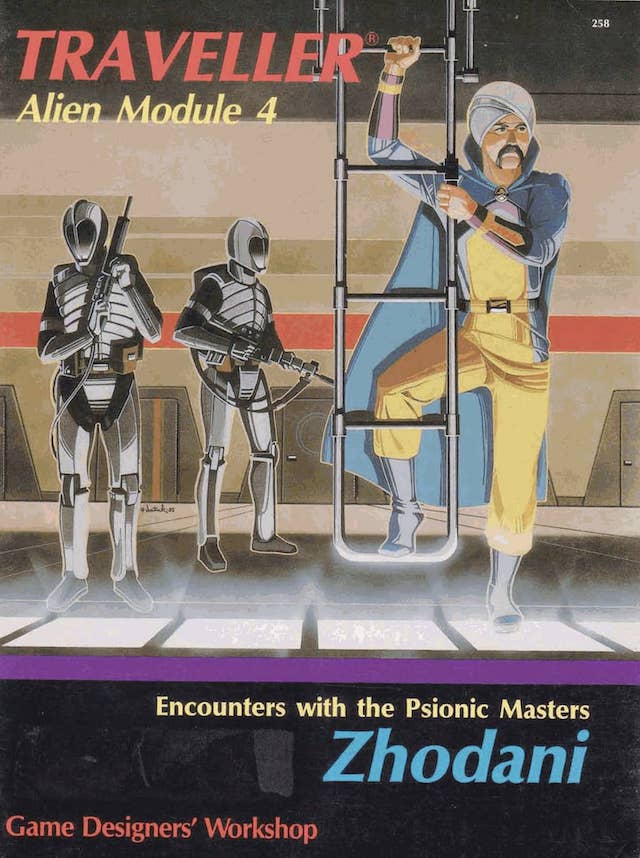
When Traveller first released in 1977, it did not have an official setting. This quickly changed with the introduction of the Third Imperium, a large, multi-star system empire. While alien species like the Hivers, Droyne, Aslan, Vargr, and K’Kree — out of many — are prominent features in many Traveller campaigns, the fact is that the Imperium is human dominated. And the Imperium’s two major foes, the Solomani Confederation and the Zhodani Consulate, are human dominated.
Part of the setting’s lore is that the so-called Ancients took humans from Earth and seeded them throughout what is called Charted Space. Often, the humans have been altered radically for the environments. Cafadans, Darmine, Darrian, and others were either altered by the Ancients or adapted to their environments and managed to survive after the Ancients destroyed themselves in a cataclysmic war.
The Zhodani, however, occupy a special place in the Traveller setting. While transplanted by the Ancients, they discovered the faster-than-light jump drive on their own accord. More importantly, they are the only human society that incorporated psionics into their culture and government. This has had a profound effect on them and on the Imperial perception of them when the two civilizations clashed in the Spinward Marches, a designated area of space.
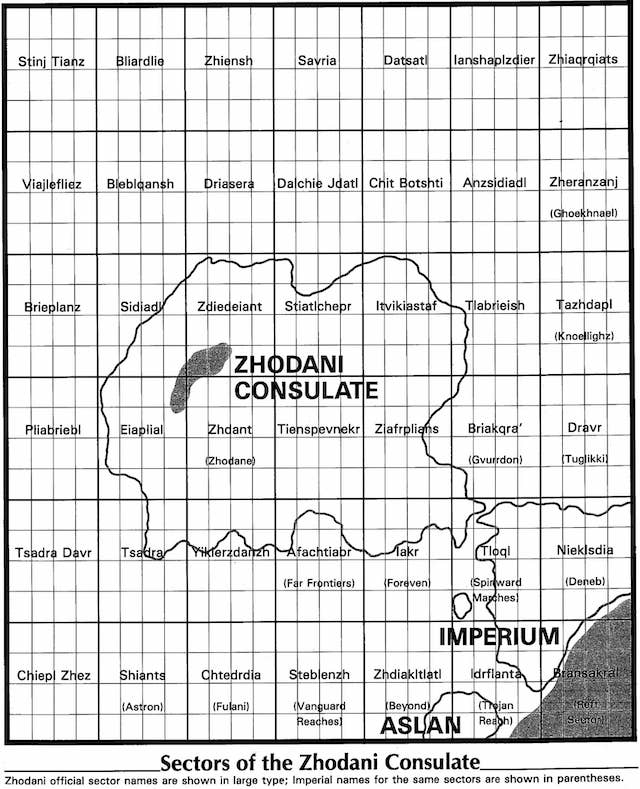
The cover of the Zhodani alien supplement for the Classic Traveller edition of the storied RPG has stuck with me for decades now. The armor of the soldiers is striking and memorable, while the unarmored person — a Zhodani noble — wearing a turban-like headdress displays confidence, power, and a bit of mystery. The Zhodani are the villains of the Traveller universe, for they are the primary opposition to Imperial interests, having fought four Frontier Wars. However, the Zhodani use of psionics is more the cause of animosity, confusion, and misunderstanding.
This supplement seeks to enlighten the GM and players on who the Zhodani are. It starts by providing preliminary data about the Zhodani’s homeworld, Zhdant. The Zhodani evolved on a world not drastically different than the humans on Earth.
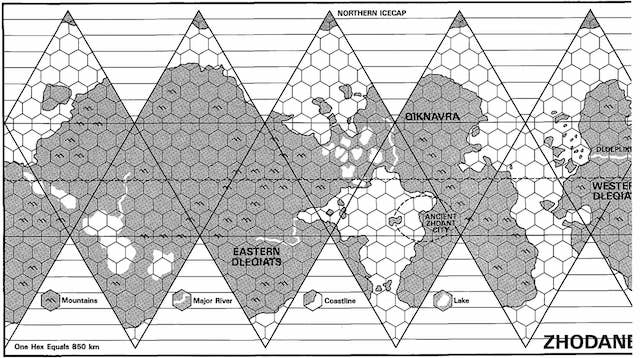
A brief history of Zhdant and the Zhodani describe the civilization they were brought in to serve. After the Ancients’ war, the Zhodani and the Ancient survivors (called Chirpers, they are caste-less Droyne). Not unlike human history on Earth, the story of humanity on Zhdant is the evolution of society from small tribal groups to feudal societies to empires bent on conquering. Eventually, the Zhodani developed space flight. One expedition went to Zhdant’s single moon, Viepchakl, where a surviving group of Chirpers still lived, though it was a grim existence. Unfortunately for them and their visitors, the Chirpers from Zhdant encountering the Chirpers from Viepchakl unlocked and activated a dormant biological agent. This agent wiped out the Chirpers and devastated the Zhodani. Society collapsed and the world returned to a dark age.
One aspect of the Chirpers the Zhodani had learned about before the collapse was that they possessed psionic capabilities. Telekinesis. Telepathy. Teleportation. They soon learned that a small percentage of the human population also possessed these abilities. This discovery is, perhaps, the reason for the way Zhodani society developed versus the Imperium, for the Zhodani came, in time, to embrace psionics in a way unlike any other major power.
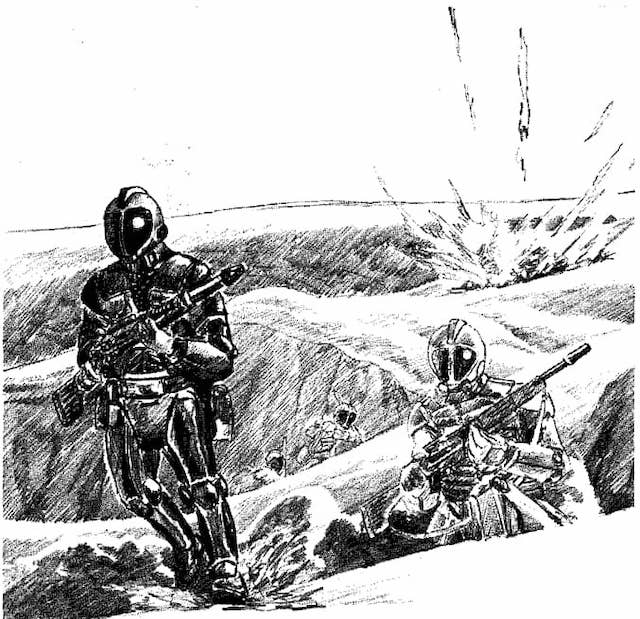
Over time, a caste-like society developed. The proles are the working class and make up the vast majority of people in the Zhodani Consulate. The proles are the farmers, factory workers, and enlisted soldiers and sailors. They are prohibited from any sort of psionic training, though those that do can be raised to the intendant class.
Between the proles and the next two classes lies the psionic gulf. The intendants make up a large portion of the population and possess psionic abilities, for which they receive limited training. They serve as managers in corporations, journalists, bureaucrats, teachers, psychologists, officers in the military, and doctors. Some intendants are assigned to serve the governing class in Zhodani society, the nobles. Intendants can rise to the noble class by meritorious service or winning at the Psionic Games, a series of Olympics like events but using psionic abilities.
The nobles also possess psionic capabilities, but they are the only citizens of the Consulate and the only ones allowed to vote and hold office. They also serve as the senior military officers. They receive extensive psionic training. The nobility governs the Consulate through a series of councils starting at the local level and rising up to the supreme council.
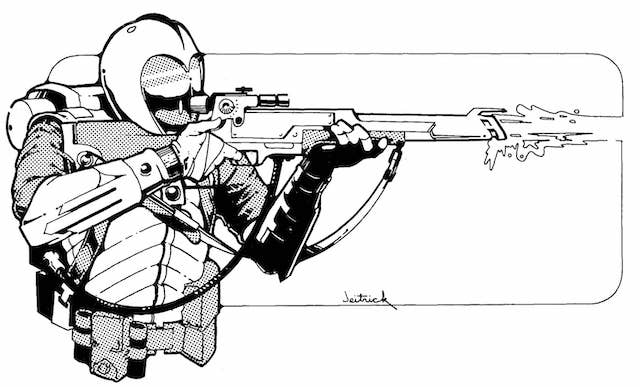
The use of psionics in society has resulted in a state where freedom does not exist in the way we think of it, but yet the population is quite content.
It has been said that psionics has made the Zhodani Consulate the most powerful, effective, and absolute tyranny in human history — and also the happiest and most stable. Both statements are quite true.
Education for the proles includes determining the best careers and rewards for them, via the use of psionics. While they can change careers, attempt artistic endeavors, and generally pursue their interests, they are denied the freedom of private thought. One of the most controversial aspects of Zhodani society is the Tavrchedl’, which the Imperials refer to as the Thought Police. In Zhodani, Tavrchedl’ means “Guardians of Our Morality.” Essentially, these are security personnel who monitor and conduct periodic evaluations of the populace. Those individuals who experience depression, frustrated dreams, and other “negative” reactions to their careers, society, and so on, are then subject to re-education. The use of telepathy has ensured the Zhodani are some of the most capable psychologists in the galaxy.
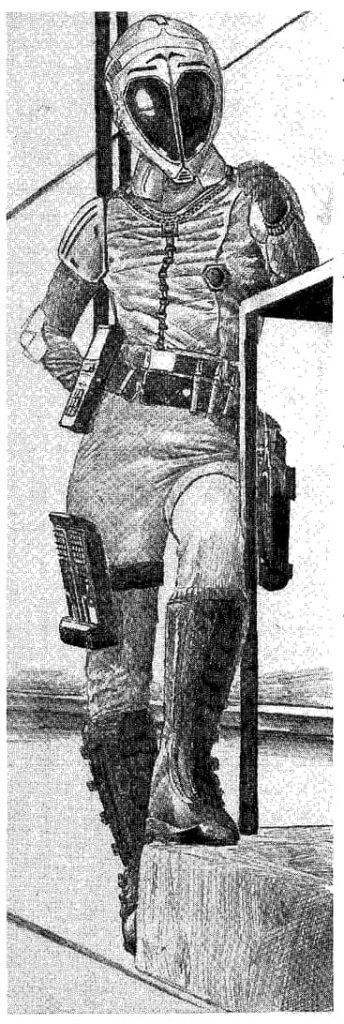
The Thought Police also conduct roaming sweeps of society in search of deviant or criminal behavior. In general, Zhodani society is scrupulously honest. Locks are rare. Crime is broken into three broad categories: Inadvertent, Incited, and Insane. Instead of prison and capital punishment, re-education is broadly used.
Intendants and nobles are afforded a level of private thought, though the intendants have less such freedom. In essence, Zhodani society’s use of psionics helps channel every person into the “optimal” path for their lives, producing a wide ranging happiness and level of conformity.
The use of psionics extends to the battlefield. The Zhodani Consular Guard is an elite force of psionic-capable soldiers, particularly in the art of teleportation. These units are particularly feared due to their ability to end up behind enemy positions instantaneously and conduct reconnaissance activities more easily than non-teleporting troops.
The Zhodani and Imperium have clashed in four wars, which have largely resulted in acrimony and little territorial gains. A fifth is looming, which is one of the crises characters can find themselves in during gameplay.
This supplement spends an entire chapter on Zhodani combat armor, outlining the various models and features. Zhodani society also makes more extensive use of robots than the Imperium, particularly in the armed services. Rules for including them are included.
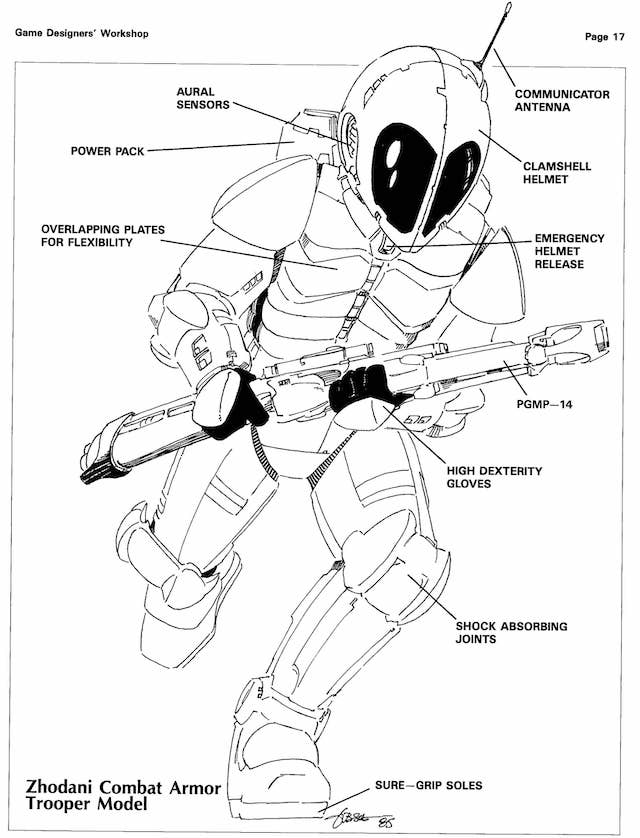
In my youthful days, I was a particular fan of the Zhodani language chapter that includes rules and tables for creating your own Zhodani words. This adds to the ability to create alien settings that are more immersive and compelling. Plus, if you like tables, plenty exist here.
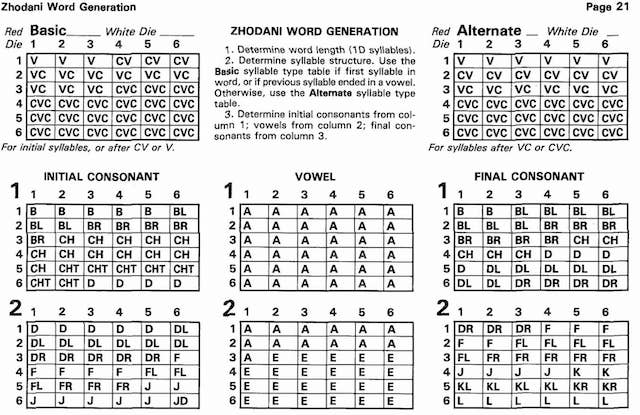
The rest of the book covers creating Zhodani characters, including mercenary and High Guard (in Traveller this is a supplement that extends naval character creation) focused ones. Character generation follows the standard Traveller rules, though with additions like the Psionic Games. Of course, psionic training is more prominent. Intendant and noble characters get psionic training by default.
A section of Zhodani starships and personal equipment ensures that players can kit up how they want and can afford. The supplement concludes with an adventure titled Vlezpridliashav. The adventure touches on one of the more fascinating and fun elements of the Zhodani: the Core Expeditions.
Most cultures around the Imperium (and including the Imperium) have had their hands full exploring and exploiting the worlds and systems within or near their own territories. The Zhodani, however, are driven by a variety circumstances and stimuli which have made the galactic core (and the route to the core) of extreme interest. Two basic data produce this effect: Ancient artifacts, and certain rare but recurring psionic effects.
In the ruins of the Ancients’ city on Zhdant, the Zhodani found an artifact containing a star map leading toward the galactic core. Importantly, the artifact proved to focus psionic abilities. What transformed the device from a curiosity to a top state secret was that in some people it produced the ability to see the future. Seven core expeditions have been launched, probing ever farther toward the core. This is a rich trove for a GM to build an exploratory campaign around. What is the nature of the device? What is its importance? What lays in wait at the end of the star map?
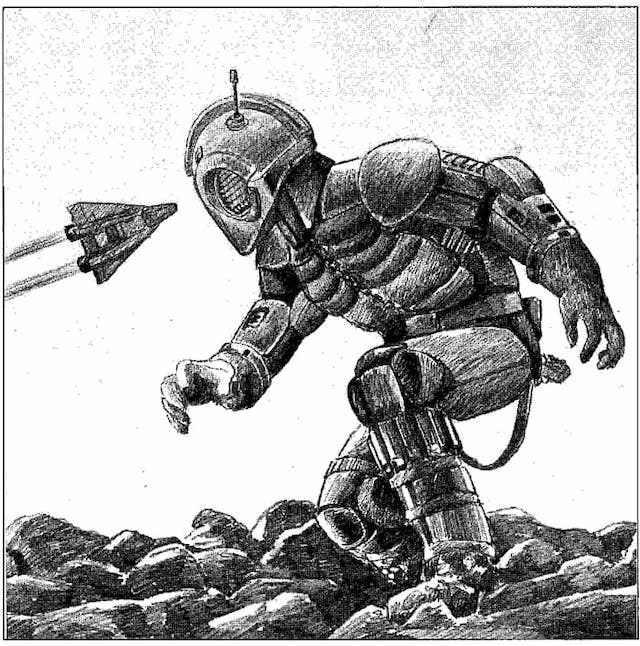
This supplement provides a GM and player all the information they need to begin playing as Zhodani or adding Zhodani as opponents or allies. The Consulate and its use of psionics provides a familiar yet alien setting to use. The material can be used with Zhodani in Imperial space, testing characters in how they deal with the psionic masters. Do they fear that they’re being “scanned” constantly? Are any former combatants in the wars between the Zhodani and Imperium. As usual, Traveller provides a rich and varied background for great stories.
You can get a copy of Zhodani in PDF form from Far Future Enterprises. In fact, you can get the entire set of Classic Traveller books and supplements for only $35.
Patrick Kanouse encountered Traveller and Star Frontiers in the early 1980s, which he then subjected his brother to many games of. Outside of RPGs, he is a fiction writer, avid tabletop roleplaying game master, and new convert to war gaming. His last post for Black Gate was Twilight: 2000’s Polish Campaign: Part III. You can follow him and his brother at Two Brothers Gaming as they play any number of RPGs. Twitter: @twobrothersgam8. Facebook: Two Brothers Gaming and Solo Twilight: 2000 game.
I too was attracted to the cover art of Alien Module 4 but it really doesn’t add anything to our campaign – we discarded Psionics from the get go. We use the Luck optional rules rather than Psionics. Unfortunately this made the Zhodani rather a dud in our Campaign – so we replaced them with the Kafers from Traveller 2300.
David, thanks for reading! Yes, I’ve run campaigns where I ditched psionics as well, which makes the Zhodani a bit irrelevant from that standpoint. My option usually was to keep them as an oligarchic tyranny but that they needed to continue to expand their empire to keep resistance at home to a minimum. That way I could keep the cool armor. 🙂
But I love the idea of the Kafers from 2300. LOVE IT. They are by far my favorite non-human species in sci-fi RPG–and make excellent villains.
Agreed, as an alien species the Kafers were a brilliant concept. It had nothing to do with their appearance , probably inspired by Predator, and everything to do with the idea that they were only barely sentient but got smarter when in danger – like an adrenal reaction.
I don’t know what inspired it but I do remember reading a short story in some anthology about a hunter on a colony world tasked with hunting down a ‘beast’ that is attacking livestock. During the course of the hunt the prey is demonstrated to be getting more sentient as the story goes on. I wish I could remember the title and author.
Thanks to both of you. Now I want to dig out my Traveller stuff AND read up on the Kafers.
Great post!
John, thanks for reading! That’s great!